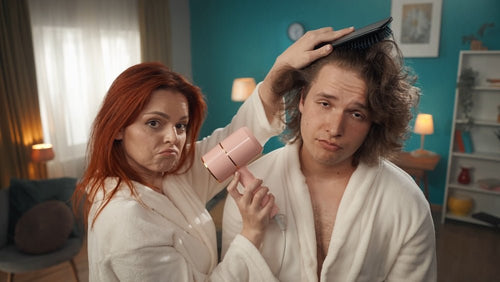Introduction
Wavy hair sits between straight and curly—blessed with volume and texture, but often misunderstood and under-cared for. If you’ve got waves that look limp one day and frizzy the next, you're not alone.
Learning how to care for wavy hair properly—both day and night—can bring out the best in your natural texture. Whether you're dealing with 2A, 2B, or 2C hair, this guide will walk you through everything you need to know to define, protect, and love your waves.
What Is Wavy Hair?
Wavy hair, also known as Type 2 hair, features strands that form a loose "S" shape. It's not straight enough to lie flat, but not curly enough to coil. Because of its in-between nature, wavy hair has unique needs when it comes to moisture, frizz control, and styling.
There are several common characteristics of wavy hair:
- It tends to frizz easily.
- It can look flat at the roots and puffy at the ends.
- It’s often weighed down by heavy products.
- It thrives with the right balance of hydration and lightweight hold.
Wavy Hair Types (2A, 2B, 2C)
Type 2A Hair
- Very loose, fine waves
- Lacks volume at the roots
- Easily straightened
- Can be weighed down by product buildup
Best routine: Use lightweight, volumizing products and avoid heavy oils or butters.
Type 2B Hair
- Defined "S" shaped waves
- Slight frizz and some volume
- Tends to poof in humidity
Best routine: Use a light leave-in conditioner and gel for hold, and try air-drying with a microfiber towel or T-shirt.
Type 2C Hair
- Coarser texture with thicker, more defined waves
- High frizz and volume
- Closest to curly hair, often confused with type 3A curls
Best routine: Moisturize well and use strong-hold stylers like mousse or curl creams to enhance and define your waves.

Common Hair Struggles
1. Frizz and Humidity
Wavy hair tends to become frizzy, particularly when exposed to humid conditions. Lack of moisture and damaged cuticles allow humidity to swell the hair shaft.
Solution: Use anti-frizz serums and seal moisture with light oils like argan or jojoba.
2. Flat Roots
Waves often fall flat at the scalp while puffing out mid-length to ends.
Solution: Try root-clipping when drying, and avoid heavy conditioners at the roots.
3. Greasiness vs. Dry Ends
Type 2 hair often has an oily scalp but dry, frizzy ends.
Solution: Use a sulfate-free clarifying shampoo weekly and deep condition the ends biweekly.
4. Undefined Texture
Sometimes waves look messy rather than styled.
Solution: Apply stylers like mousse, curl-enhancing spray, or light gel on damp hair, and avoid touching as it dries.
Wavy Hair Routine – Day & Night Routine
Morning Routine
- Refresh or Wash: Depending on how your waves hold overnight, you might co-wash or refresh with water and a curl-reviving spray.
- Style on Damp Hair: Apply leave-in conditioner or a curl cream, then rake in mousse or gel. Scrunch upward to encourage wave pattern.
- Drying: Air-dry or diffuse on low heat. Avoid towel-drying with a regular towel—use a microfiber towel to reduce frizz.
- Finish: Once dry, scrunch out the crunch (SOTC) if using gel, and apply a tiny bit of oil for shine and definition.
Night Routine
- Use a Satin or Silk Pillowcase: Regular cotton pillowcases cause friction, which can lead to frizz, split ends, and moisture loss. Switch to satin or silk to keep waves smooth and hydrated.
- Wrap Your Hair in a Satin Bonnet: For more complete protection, especially if you toss and turn, wear a satin bonnet. It keeps your wave pattern intact and prevents hair from rubbing against rough bedding.
- Try the Pineapple Method: Gather your hair loosely at the crown of your head using a satin scrunchie. This prevents flattening your waves and preserves volume for the next morning.
- Use a Lightweight Leave-In Spray: If your hair tends to dry out overnight, mist a hydrating spray or light leave-in before wrapping it. This adds a protective moisture layer while you sleep.
- Braid or Twist (Optional): For 2C or frizz-prone waves, try two loose twists or a braid. This helps control tangling and reduces breakage by keeping your hair more contained.
- Avoid Sleeping With Wet Hair: Sleeping on damp or wet waves can ruin the wave pattern and cause breakage. Always dry thoroughly before bed, even if you air-dry partially during the evening.
Common Mistakes to Avoid
1. Overwashing
Washing your hair daily can strip natural oils that keep waves healthy. Aim for 2–3 times per week and use dry shampoo or refreshing sprays in between.
2. Using the Wrong Products
Heavy butters, silicones, and alcohol-laden sprays can weigh down or dry out your waves. Always check ingredient lists and stick to products labeled for wavy or curly hair.
3. Brushing Dry Hair
Brushing disrupts your wave pattern and causes frizz. Detangle in the shower with conditioner and a wide-tooth comb only.
4. Skipping Heat Protection
If you use a diffuser, curling wand, or any heat tools, always apply a heat protectant spray. Wavy hair is especially prone to heat damage.
5. Ignoring the Weather
Humidity, wind, and dry air affect wavy hair differently. In summer, use anti-frizz and anti-humidity serums. In winter, deep condition regularly to combat dryness.

Best Wavy Hair Products
Here are product types that work best for type 2 hair:
Cleansing
- Low-poo shampoo: Gentle cleansers that don’t strip natural oils (look for sulfate-free).
- Co-wash: Ideal for dry or damaged waves.
Conditioning
- Lightweight conditioners: Avoid heavy silicones and go for nourishing yet breathable formulas.
Styling
- Mousse: Perfect for adding volume without weighing waves down.
- Curl-enhancing spray: Adds definition and helps revive next-day waves.
- Light-hold gel or custard: Great for reducing frizz and holding wave patterns.
- Leave-in conditioner: Hydrates and primes the hair for styling.
Bonus Tools
- Wide-tooth comb: Helps detangle without breaking your wave pattern.
- Microfiber towel or cotton T-shirt: Reduces frizz while drying.
- Diffuser: Speeds up drying time and enhances natural texture.
Bonus tip: Look for products labeled “for wavy or curly hair,” and avoid those with drying alcohols.
Final Words
Wavy hair can feel like the most unpredictable hair type—but with the right approach, it can become your favorite feature. Whether you’re rocking beachy 2A waves or thick 2C strands, the key is finding a routine and product lineup that lets your hair thrive.
Take the time to experiment, listen to your hair’s needs, and treat it with care. And remember: waves are not meant to be tamed—they’re meant to be celebrated.



